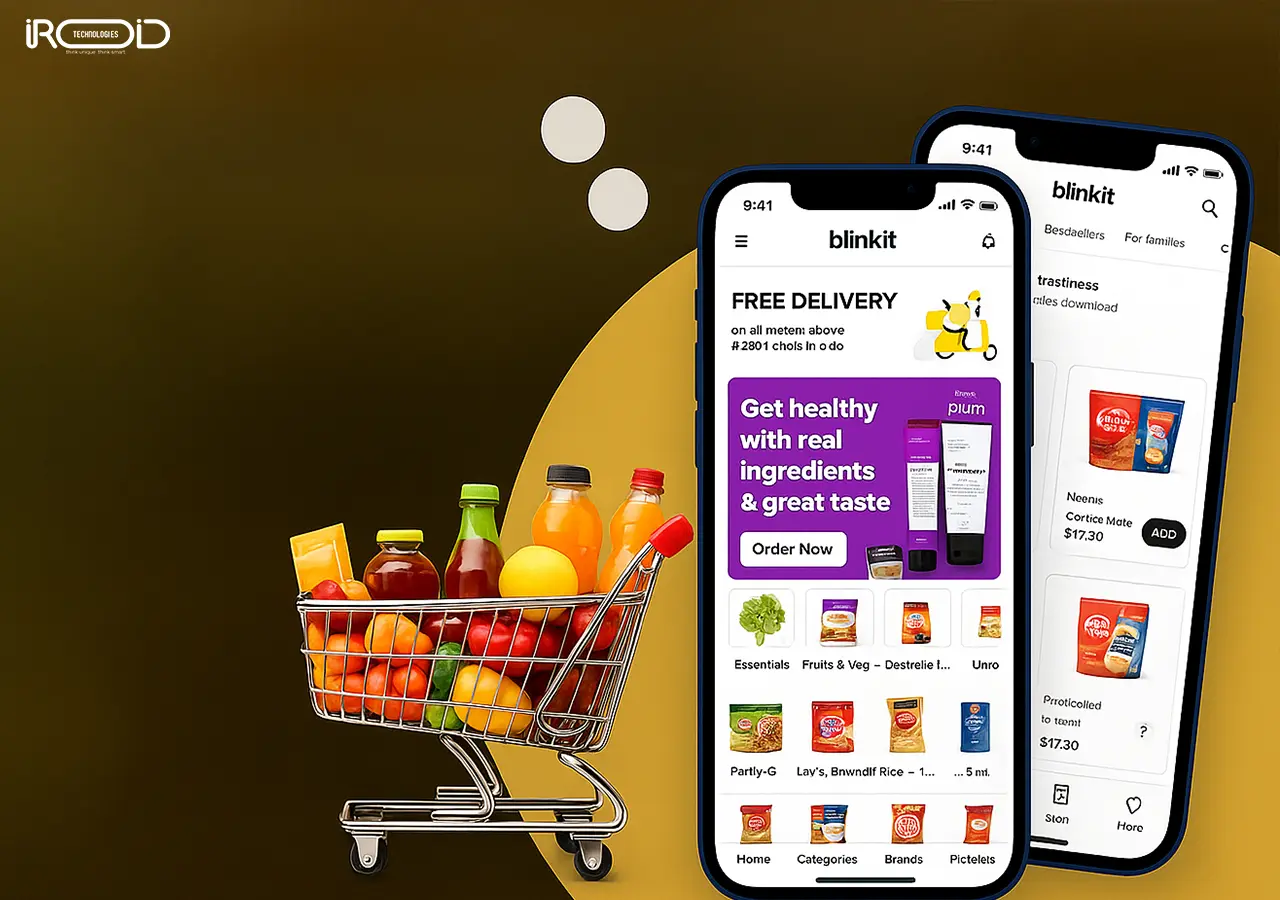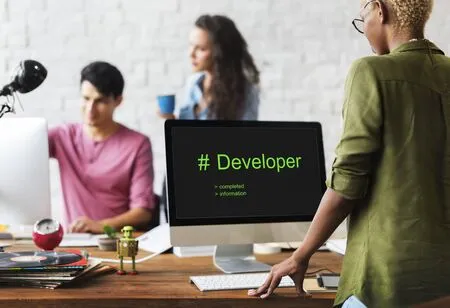How Much Does It Cost To Develop an App Like Blinkit?

The instant delivery market has expanded rapidly and is no longer easy to miss. In 2020, the company made $1.175 billion and a year later, in 2021, it had jumped to $4.7 billion. The market increased from $585 billion in 2022 to its forecasted height of $2.3 trillion by the end of this decade. What these numbers show is how the industry is reinventing our approach to shopping.
Because of Blinkit, DoorDash, Deliveroo and Zepto, companies everywhere are starting to see what quick-commerce applications can do. This surge has led many entrepreneurs to seek partnerships with a reliable mobile app development company in India to capitalize on this booming market and create their own instant delivery solutions.
The progress Blinkit (originally Grofers) made, ending up worth $568 million, suggests great prospects in this field. Everyone interested in starting a company wants to know: just how much does it actually take to develop an app like Blinkit?
The book covers the different costs involved, necessary features to include, the right technology to choose and how these help shape your quick-commerce venture.
Understanding Blinkit: The Quick-Commerce Pioneer
Blinkit’s experience demonstrates how making changes can lift a business to market leadership. Launched originally in 2013 under the name Grofers, the business began connecting users with nearby shops for delivery. Nevertheless, the first marketplace concept did not reach the hoped-for results.
At the start of 2021, Grofers decided to rebrand as Blinkit and alter how it did business. Instead of setting up connections between local merchants and their customers, they turned to warehouses and started using their own quality assessment systems.
At the moment, Blinkit serves customers in 23+ major cities in India, including Bengaluru, Delhi, Mumbai and Pune. Customers have access to over 7,000 items, both for groceries and home and all orders are promised within 10 minutes.
The business has to compete with Instamart by Swiggy, along with new names like Zepto, Soonicorn and Dunzo (backed by Reliance). Because of the competition, firms are expected by customers to keep improving on speed, product standards and the range of services provided.
Blinkit's Business Model Deep Dive
Understanding Blinkit's model evolution helps appreciate why development costs vary dramatically based on your chosen approach.
Original Marketplace Model (2013-2021)
The initial Grofers model was technically simpler, connecting buyers seeking convenience, local sellers needing broader reach, and delivery teams facilitating connections. Grofers earned 8-15% commission from vendors for sales and deliveries, acting as a middleman with lower inventory costs but less customer experience control.
This model faced challenges: coordinating multiple vendors meant inconsistent quality, unpredictable delivery times, and limited control over the customer journey.
Current Inventory-Based Model
The shift to inventory-based operations was bold but necessary. Blinkit currently offers dark shops, which are micro-warehouses within two km of service zones. They purchase inventory directly, conduct quality checks, and manage entire fulfillment processes in-house.
This approach provides better quality control and faster delivery but requires substantial investment in technology, infrastructure, and working capital. From development perspective, it demands sophisticated inventory management, real-time tracking, demand forecasting, and complex logistics optimization.
Cost Breakdown: Developing an App Like Blinkit
Development Cost Tiers
When entrepreneurs ask about development costs, the answer isn't straightforward because it depends on the complexity and features you want to include. Let me break this down into realistic tiers:
Basic App Development ($5,000 - $10,000)
A basic version would include essential functionalities like user registration and login, product catalog browsing, shopping cart functionality, basic payment gateway integration, simple order tracking, and fundamental delivery management features. Having a minimal viable product (MVP), this tier is appropriate for evaluating market viability.
However, it's important to understand that a basic app won't compete effectively with established players like Blinkit. It's more of a starting point to validate your business concept and gather user feedback before investing in more advanced features.
Advanced App Development ($15,000 - $30,000)
This tier includes everything from the basic version plus real-time order tracking with GPS integration, in-app messaging between customers and delivery partners, personalized product recommendations based on user behavior, promotional campaigns and discount management, loyalty programs and rewards systems, push notifications for order updates and marketing, and basic analytics dashboards.
An advanced app provides a much better user experience and includes features necessary to compete in today's market. When you hire an app developer for this tier, you're investing in functionality that can significantly improve customer retention and engagement.
Enterprise-Level App ($40,000 - $80,000+)
The enterprise level includes all previous features plus AI-powered product recommendations and demand forecasting, hyperlocal delivery optimization algorithms, voice search and AI chat support, advanced analytics with business intelligence dashboards, multi-vendor management systems, sophisticated inventory management with automated reordering, and integration with IoT devices for smart inventory tracking.
This tier is what you need to build a truly competitive quick-commerce platform that can scale and compete with established players.
Factors Affecting Development Costs
Several factors significantly impact development costs beyond basic functionality. The choice of technology stack is crucial – cross-platform solutions can reduce costs but might compromise on performance, while native development offers better performance but increases costs.
The complexity of your user interface and user experience design also matters. A simple, clean design costs less than a highly interactive, animation-rich interface. However, in the competitive quick-commerce space, user experience can be a key differentiator.
Third-party integrations add to costs but are essential for functionality. Payment gateways, mapping services, SMS providers, and analytics tools all come with integration costs and ongoing fees.
Backend infrastructure requirements vary based on expected user load and features. A robust, scalable backend that can handle thousands of concurrent users costs more than a basic setup but is essential for growth.
Regional Development Cost Variations
Development costs vary significantly based on location. While you might pay $100-200 per hour for developers in North America or Western Europe, skilled developers in India might charge $25-50 per hour without compromising on quality. This cost difference is why many businesses choose to work with development teams in India or other cost-effective regions.
Technology Stack and Development Considerations
Frontend Development Options
For your app's frontend, selecting the appropriate technology is essential in terms of both price and functionality. React Native app development has become increasingly popular for quick-commerce apps because it allows you to build for both iOS and Android platforms simultaneously, reducing development time and costs by up to 40%.
Flutter app development is another excellent option, especially if you want a highly customized user interface with smooth animations. Flutter apps tend to perform exceptionally well and provide a native feel across platforms.
Native development (separate iOS and Android apps) offers the best performance and platform-specific features but comes with higher costs and longer development timelines. For a quick-commerce app where performance is crucial, this might be worth the investment.
Backend and Infrastructure Requirements
The backend is where the real complexity lies in quick-commerce applications. You need robust software development practices to handle real-time inventory updates, order processing, payment handling, and delivery tracking simultaneously.
Key backend components include user management systems, product catalog management, inventory tracking with real-time updates, order processing and workflow management, payment processing and wallet management, delivery tracking and route optimization, and analytics and reporting systems.
Cloud infrastructure is essential for scalability. Services like AWS, Google Cloud, or Microsoft Azure provide the reliability and scalability needed for quick-commerce applications.
Essential Third-Party Integrations
Modern quick-commerce apps rely heavily on third-party services. Payment gateways like Stripe, Razorpay, or PayPal are essential for handling transactions securely. Mapping services like Google Maps or Mapbox enable location-based features and delivery tracking.
Communication services for SMS notifications, email marketing, and push notifications are crucial for customer engagement. Analytics tools help you understand user behavior and optimize your app's performance.
Step-by-Step Development Process
Pre-Development Phase
Planning is crucial before you write a single line of code. Market research helps you understand your target audience, competition, and local regulations. Defining your unique selling proposition is crucial – what will make customers choose your app over Blinkit or other established players?
Choosing your initial product categories strategically can help you start small and expand gradually. Blinkit started with groceries and expanded to 7,000+ products over time. Starting focused allows you to perfect your operations before scaling.
Technical requirement documentation ensures everyone understands exactly what needs to be built, reducing miscommunication and cost overruns during development.
Development Phase
The development phase should follow agile methodology, allowing for iterative improvements and regular feedback. Starting with an MVP lets you launch quickly and gather real user feedback before investing in advanced features.
Quality assurance and testing are crucial, especially for quick-commerce apps where bugs can directly impact customer orders and deliveries. Comprehensive testing across several devices, networks, and situations is required.
Security implementation cannot be an afterthought. With payment processing and personal data handling, robust security measures are mandatory from day one.
Launch and Post-Launch
App store optimization ensures your app is discoverable when users search for delivery services. User acquisition strategies, including referral programs and promotional campaigns, help build your initial user base.
Long-term success requires constant development based on analytics data and customer input. The quick-commerce space evolves rapidly, and staying competitive requires constant innovation.
Why Choose Professional Development Services
Partnering with an experienced development company brings numerous advantages. They have expertise in quick-commerce app development, understanding the unique challenges and requirements of this industry. Their proven track record with similar projects means they can anticipate and avoid common pitfalls.
Working with an IT consulting company provides strategic guidance beyond just development. They can help you make informed decisions about technology choices, feature prioritization, and market entry strategies.
End-to-end development and support means you have a single point of contact for everything from initial planning to post-launch maintenance and updates.
Key Considerations When Selecting a Development Partner
When evaluating potential development partners, examine their portfolio carefully. Look for apps similar to what you want to build and assess their quality and user reviews.
Technical expertise matters, but so does team composition. You want developers, designers, project managers, and quality assurance specialists who can work together effectively.
Project management approach should be transparent with regular updates and clear communication channels. Post-launch support and maintenance are crucial – your app will need updates, bug fixes, and new features regularly.
Future Trends and Considerations
Emerging Technologies
New technologies continue to change the quick-commerce sector. AI and machine learning are becoming standard for demand forecasting, personalized recommendations, and route optimization. IoT integration for smart inventory management helps reduce waste and improve stock accuracy.
Blockchain technology is emerging for supply chain transparency, allowing customers to track products from source to delivery. These technologies will likely become competitive necessities rather than nice-to-have features.
Market Expansion Opportunities
Even though most of the action takes place in large cities, rural regions provide many opportunities. Moving abroad is a popular choice for companies with successful business models.
When a company, like Blinkit, goes from a marketplace to an inventory model, it can take charge of more of the value chain and increase its profit.
Conclusion
Blinkit-like applications need detailed planning, having enough investment and requiring a strong focus on continuous improvement. A MVP might cost $5,000, but a full-scale solution can set you back over $80,000, depending on what your business calls for.
You should know that the real investment starts after the first development cost. Businesses in quick-commerce must always spend money on upgrading their technology, running effective marketing efforts, managing their operations and bringing in new customers. Even so, the market is expected to reach $2.3 trillion by 2030 which makes putting capital in here worthwhile for solid investors.
Think about what your business needs, pick the best method for building your app within your budget and schedule and realize that standing out involves releasing fast and adjusting to new trends. Applications that see success have quick launches, study what users like and change quickly using actual usage information.

